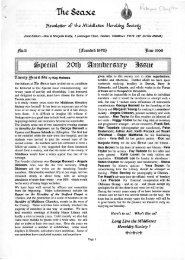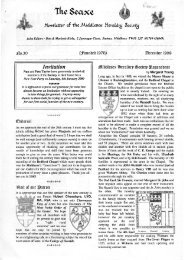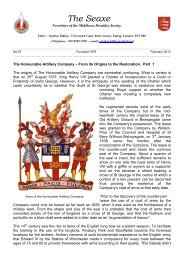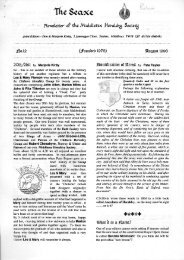The Seaxe - Middlesex Heraldry Society
The Seaxe - Middlesex Heraldry Society
The Seaxe - Middlesex Heraldry Society
Create successful ePaper yourself
Turn your PDF publications into a flip-book with our unique Google optimized e-Paper software.
arry wavy of four pieces Argent and Azure and over all a<br />
pale Sable charged with three Silver scallop shells. Crest<br />
- On a wreath Gold and Gules a swan's head and neck<br />
proper issuing from a wreath of oak Or. Supporters -<br />
Dexter a lion Gules and sinister a Gold bull.<br />
*********<br />
Scott-Giles asserts that the Corporation of Dunstable,<br />
having no arms of. its own, and<br />
completely without authority,<br />
incorporated those of the Priory in<br />
its seal. In the course of time<br />
corruption crept in - perhaps<br />
through a lack of skill or the<br />
ignorance of some seal engraver;<br />
the pile became longer and<br />
narrower, the horseshoe and ring<br />
Device used<br />
by the Borough<br />
degenerated into a meaningless<br />
twist projecting from the side of<br />
the pile, until finally the emblems assumed the shape of<br />
an ale-warmer. <strong>The</strong> arms are blazoned - Argent an alewarmer<br />
within a bordure engrailed Sable.<br />
Saint Cecilia<br />
According to a highly dubious tradition Saint Cecilia was<br />
a Roman maiden of patrician birth compelled to marry a<br />
young pagan, Valerian, despite a<br />
vow of celibacy. She succeeded in<br />
persuading him to respect her vow,<br />
and converted him to Christianity.<br />
<strong>The</strong>y were both put to death for<br />
their faith. Saint Cecilia is the<br />
patron saint of musicians and<br />
composers. It was believed that<br />
angels left heaven and returned to earth to listen to her<br />
play music although it is said that the only apparent<br />
reason for her to be known as the patroness of music is<br />
that she was skilled in singing the divine praises, often<br />
accompanied by an instrument. Her badge is described<br />
as:- A Gold harp with Silver strings on a Blue field<br />
Did You Know?<br />
+ + + + + +<br />
More than 75% of the Tudor diet was<br />
meat! On average a Tudor courtier<br />
would eat between 4500 and 5000<br />
calories a day, over twice the present<br />
norm. In fact, in one year the Tudor<br />
court ate more than 1240 oxen, 8200<br />
sheep, 2330 deer, 760 calves, 1870 pigs and 53 wild boar.<br />
Each course of a Tudor meal was like a buffet, with the<br />
leftovers being passed to the serving staff and their<br />
leftovers being passed to the beggars at the gate.<br />
++++++<br />
4<br />
<strong>The</strong> Ward Names of <strong>The</strong> <strong>Middlesex</strong><br />
Hospital by Margaret Backhouse<br />
Having been persuaded by your Editors to produce a<br />
short piece for the excellent 25th Anniversary Issue of<br />
<strong>Seaxe</strong> on <strong>The</strong> <strong>Middlesex</strong> Hospital, I became interested<br />
in the ward-names. Names like Charles Bell, Bland-<br />
Sutton and Webb-Johnson, all famous in the medical<br />
world, were obvious, but who were "Athlone",<br />
"Meyerstein" and "Lord Ludlow" to name but three?<br />
On the death of Prince Francis in 1910, his brother,<br />
Prince Alexander of Teck was invited to succeed him as<br />
Chairman of the Board of Governors. When King George<br />
V abolished titles of German origin during the first World<br />
War, Prince Alexander became the Earl of Athlone. He<br />
was a very popular Chairman but had to resign in 1924<br />
when he was appointed Governor-General of South<br />
Africa. On his return to England he renewed his interest<br />
in medical education and was the Chancellor of the<br />
University of London until his death in 1957. From 1940<br />
to 1946 he was also a very successful Governor-General<br />
of Canada.<br />
Although there had been a Bentinck Ward named in<br />
1879, in the rebuilt hospital in the 1930's this became<br />
Cavendish-Bentinck, referring to a Frederick J.<br />
Cavendish-Bentinck. He was a member of the Board of<br />
Governors for 42 years and played an important part in<br />
the rebuilding of the hospital. He was the manager of the<br />
Howard de Walden estate which was originally part of<br />
the Duke of Portland's estate and was brought to the<br />
family by marriage in the 19th century. Nan Taylor, in<br />
her article on the Lords Lieutenant of <strong>Middlesex</strong>,<br />
illustrates the arms of the Duke of Portland - quarterly<br />
Bentinck and Cavendish.<br />
Lord Howard de Walden after whom a ward is named<br />
was elected to the Board of Governors at the end of the














